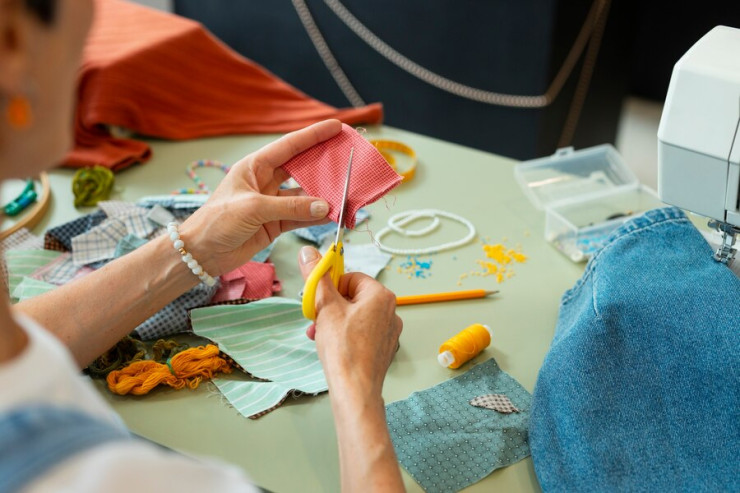Cutting and Stitching

Cutting and Stitching: Bringing Your Clothing Brand's Designs to
Life
Once you’ve completed the design, fabric sourcing, and pattern making for
your clothing brand, it’s time to turn those concepts into real garments.
Cutting and stitching are the key production processes that transform raw
materials into finished products. These steps require precision, skill, and
careful planning to ensure your designs are executed flawlessly.
Why Cutting and Stitching Are Critical
Cutting and stitching are not just routine tasks; they directly impact the
quality, fit, and overall look of your garments. Poorly cut fabric can lead to
uneven seams and wasted materials, while subpar stitching can affect durability
and appearance. That’s why it's essential to invest in skilled labor and
high-quality machinery for this phase of production.
Cutting: Precision is Key
Cutting is the process of slicing fabric into the desired shapes and sizes
according to the pattern. It is a meticulous task that requires attention to
detail to ensure that each piece matches the pattern exactly.
Steps in the Cutting Process:
1. Fabric
Layout: Before cutting, the fabric is laid out in layers or spreads,
often using an automated spreading machine for large production runs. The
fabric must be smooth, wrinkle-free, and aligned properly to avoid errors.
2. Marking
the Pattern: Using the pattern template, the outlines of the pieces
are marked onto the fabric. This can be done manually with chalk or
automatically using a laser or marker on computer-controlled cutting systems.
3. Cutting
the Fabric: Once the fabric is marked, the cutting begins. The method
of cutting can vary depending on the type of fabric and the production scale:
- Manual Cutting: For small
batches, handheld cutting tools like shears or rotary cutters are used.
- Automated Cutting: For
larger production runs, fabric is cut using machines such as straight
knives, band knives, or computerized laser cutting systems for precision
and speed.
4. Quality
Control: After cutting, the fabric pieces are inspected to ensure they
meet size and shape specifications. Any defects or inconsistencies are
identified at this stage.
Importance of Cutting Accuracy
- Fabric Utilization:
Efficient cutting minimizes fabric waste, which helps keep production
costs down.
- Consistent Fit: Precision
in cutting ensures that every piece of fabric fits together seamlessly
during stitching, resulting in well-fitting garments.
- Quality Control: Any
mistake in cutting can affect the entire garment, making accuracy crucial
for maintaining high quality in production.
Stitching: Bringing Pieces Together
Once the fabric pieces are cut, stitching is the process that joins them to
form the finished garment. Stitching needs to be strong, neat, and consistent
to ensure durability and an appealing finish.
Types of Stitching:
1. Lockstitch:
The most common stitch in garment production, used for basic seams. It provides
a strong, tight stitch that is durable and versatile.
2. Chainstitch:
Often used for stretchy fabrics like knitwear, this stitch is flexible and
allows the garment to move without breaking the seam.
3. Overlock
(Serger) Stitch: Used to finish the raw edges of the fabric,
preventing fraying and giving the garment a clean, professional look. It’s
particularly important for woven fabrics.
4. Topstitching:
Decorative stitching that also reinforces seams, often seen on collars, cuffs,
and hems.
5. Flatlock
Stitch: Commonly used in activewear, this stitch lies flat against the
body, reducing bulk and increasing comfort.
Stitching Process:
1. Assembling
the Garment: Stitching begins by sewing smaller pieces together (such
as sleeves or collars) before assembling the full garment. Each seam must align
perfectly for the garment to maintain its intended shape and fit.
2. Sewing
Seams: Different seam types, such as plain seams, French seams, or
flat-felled seams, are used depending on the garment and fabric. Strong,
accurate seams ensure the garment can withstand wear and tear.
3. Finishing
Touches: After the main seams are sewn, finishing details like
hemming, adding buttons, zippers, or trims, and applying labels are completed.
4. Inspection:
Once the garment is fully stitched, a final quality inspection is done. This
includes checking for stitching errors, loose threads, and overall seam
strength.
Challenges in Cutting and Stitching
1. Fabric
Behavior: Different fabrics behave differently during cutting and
stitching. Delicate fabrics like silk require extra care, while stretchy
fabrics need special handling to maintain shape.
2. Consistency
in Large Batches: Maintaining consistency across large production runs
can be difficult. Automated machinery and skilled operators are necessary to
ensure uniform quality.
3. Labor
Costs: Skilled labor for cutting and stitching can be costly,
especially for intricate designs that require more manual work.
Tips for Successful Cutting and Stitching
1. Invest
in Technology: Modern cutting and stitching machines offer precision,
speed, and consistency, reducing the margin for error and saving time.
2. Use
Skilled Labor: While automation is useful, skilled operators are
essential for handling complex designs and ensuring quality craftsmanship.
3. Pre-Production
Sampling: Always create a sample garment before full-scale production
to test the cutting and stitching processes. This allows for any necessary
adjustments to be made ahead of time.
4. Focus
on Quality Control: Implement a thorough quality control process to
catch issues early. This can save time and costs by avoiding defects in the
final product.
Conclusion
Cutting and stitching are the backbone of garment production, turning your
designs into reality. Precision in cutting ensures that fabric is used
efficiently and that the pieces fit together perfectly, while skilled stitching
brings the garment to life. Investing in quality materials, technology, and
skilled labor will result in well-crafted garments that reflect the quality of
your clothing brand.
Ready to bring your designs to life? Focus on cutting and stitching
excellence to create garments that stand out in the market!